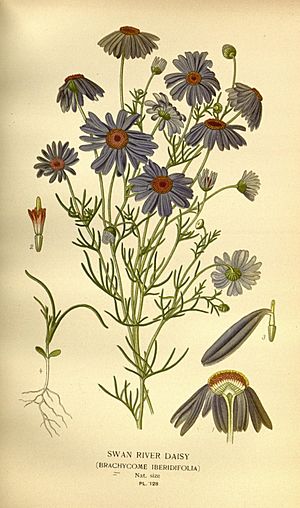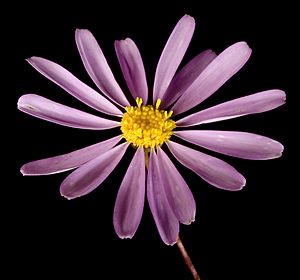Swan River daisy facts for kids
Quick facts for kids Swan River daisy |
|
|---|---|
 |
|
| Brachyscome iberidifolia | |
| Scientific classification | |
| Kingdom: | |
| (unranked): | |
| (unranked): | |
| (unranked): | |
| Order: | |
| Family: | |
| Genus: |
Brachyscome
|
| Species: |
B. iberidifolia
|
| Binomial name | |
| Brachyscome iberidifolia |
|
The Swan River daisy (its scientific name is Brachyscome iberidifolia) is a beautiful plant that grows for one year. It is an annual herb found in Western Australia. This plant grows across a large area, often spreading out to cover entire fields.
Its daisy-like shape and bright colors were well-known to Europeans when they first discovered it. Since then, it has become a very popular plant for gardens. The Swan River daisy is tough and can grow well even in poor or sandy soils. It still puts on a wonderful display of flowers.
What Does the Swan River Daisy Look Like?
This annual plant grows upright and has many branches. It can form large fields of plants, reaching up to 400 mm (about 16 inches) tall. The leaves of the Swan River daisy are deeply divided. Each part of the leaf is long and narrow, branching out from the main stem.
The flowers are like small daisies and come in many colors. You can find them in white, pink, blue, and even violet. These pretty flower heads usually appear between August and May in their natural home.
Where Does the Swan River Daisy Grow?
The Swan River daisy is found all over Western Australia. It can grow in sandy or clay soils and can even handle salty conditions. This plant often prefers areas near water or low spots near granite rocks.
However, it also grows well on sandhills and in tough coastal environments. You can find it far north in the Pilbara region. It also grows in the Murchison, Gascoyne, and Coolgardie regions. It has even been seen in the Gibson Desert. Many records show it along the western and southern coasts. It has also been found on East Wallabi Island in the Abrolhos Islands.
This daisy is often part of the amazing mix of wildflowers. These flowers bloom in the heaths, woodlands, and plains of Western Australia.
How to Grow Swan River Daisies
The Swan River daisy is often grown in gardens. You can easily grow it from seeds. There are different types of Swan River daisies that people have grown. One popular type is called 'Blue Star'.


